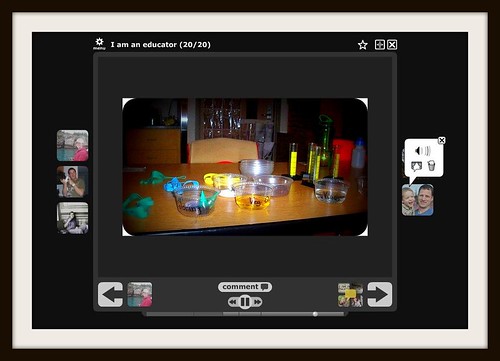The nature of this web site made it accessible for students with a wide variety of abilities to use and have a positive experience with. By giving out a graphic organizer with open ended instructions, all students were able to write to the best of their ability. One area that some students had trouble with was typing the web address into the browser; even though I created a portal ahead of time with a simpler address than the actual web site's web address, some students still took several minutes to actually make it to the web site. Considering the fact that we were using a class set of lap tops which is often an invitation for technical difficulties, this was a relatively minor problem, and I am happy to say that we had no major tech. problems during the rest of the lesson.
The students that required the most differentiation during this activity were actually the higher students who enjoyed the activity and participated in it fully but finished much quicker than the rest of the class. The web site had a section where students could read about the different forces, but even that was something they breezed through, so I had them do an extra activity which they seemed to enjoy, and one student even found another web site that we may use later on in this unit.
Outcomes:
One of the most exciting outcomes occurred when I took up the observation papers and saw that every single student had completed the majority of the paper, and one student in particular made me very happy with his writing. This particular student is a low reader and almost never writes a single word in class, but he wrote quite a lot himself then sought help from Nancy to finish writing the last few sentences which is a great step for him in becoming self-advocating in his learning.
By looking at their notes and listening to the group discussion after the activity, I think that the lesson helped students begin to form ideas about exactly how different forces shape the land, and it prompted many students to make connections between the Planet Earth videos they had been watching. I think that by the time students actually start reading about land forms they will have sufficient background knowledge to be able to make deep connections and understandings.
Communicating Expectations/Critical Thinking
At the beginning of the lesson, I explicitly wrote my objectives out on the white board and talked about my objectives for the lesson with the students. I told them that I wanted them to investigate the idea of how different forces shape the land and practice taking notes. As I mentioned above, I also talked about how important computer modeling is to science. I also had all of the instructions for the activity printed on their observation sheet so that students could easily reference what to do next when they finished a task.
Students used critical thinking while actually playing the game where they had to use their prior knowledge to make reasonable guesses. They also synthesized the information as they took notes on what they had learned, and evaluated the lesson and their own learning during the closing discussion.
Improvements for Next Time:
Over all, I was very pleased with how this lesson went. It was a huge relief to have the lesson go off with relatively few glitches in the technology, and I was very pleased by the overall positive reaction to the web site from the class. The one area of my lesson that could have used some improvement was my final discussion. The class seemed a little squirmy from the activity, and some students were starting to check out instead of participating in the discussion. In the future, I think I would pre-write my review questions instead of trying to think them up on the spot because I could have done a better job of questioning for deep reflection.

